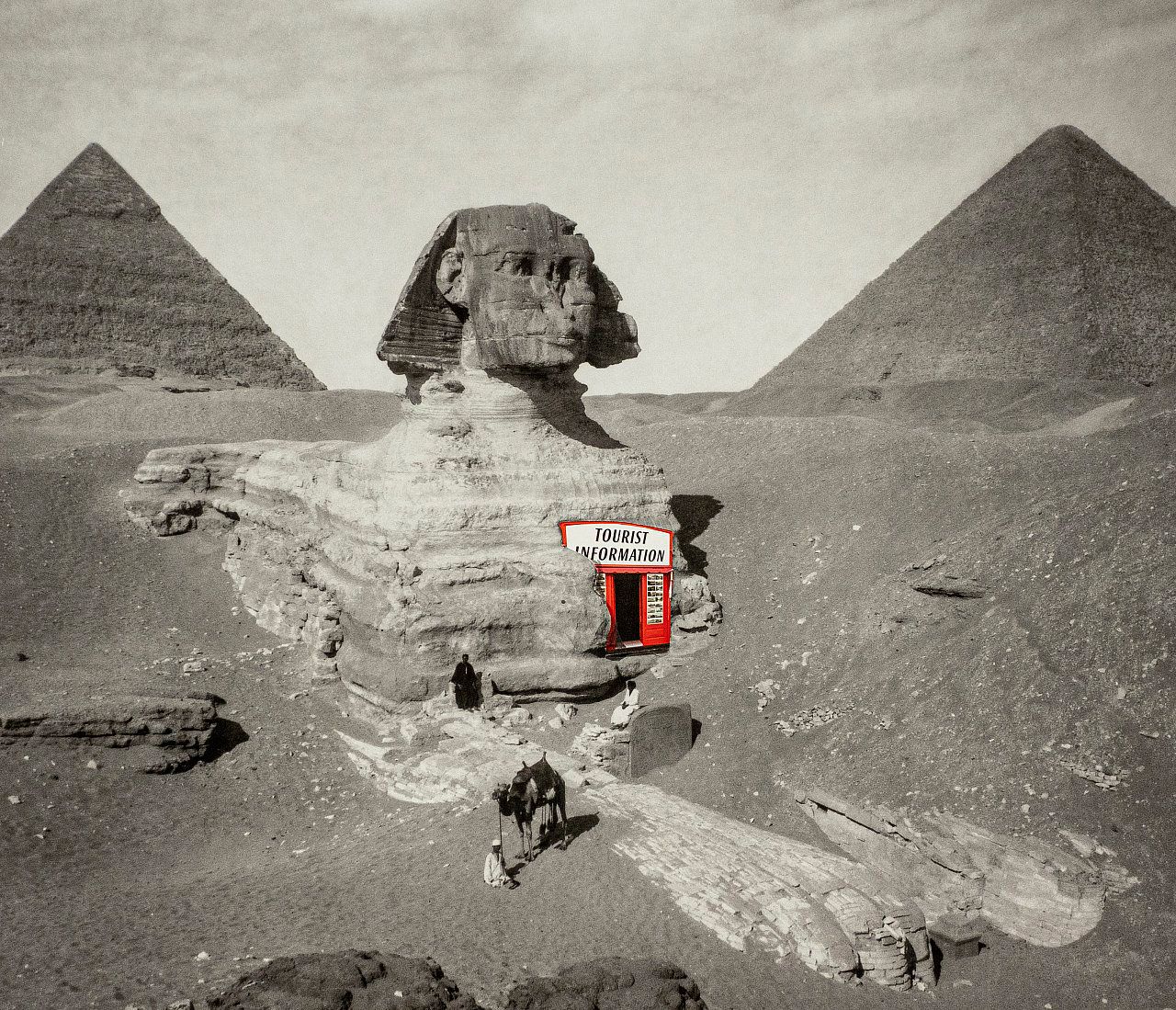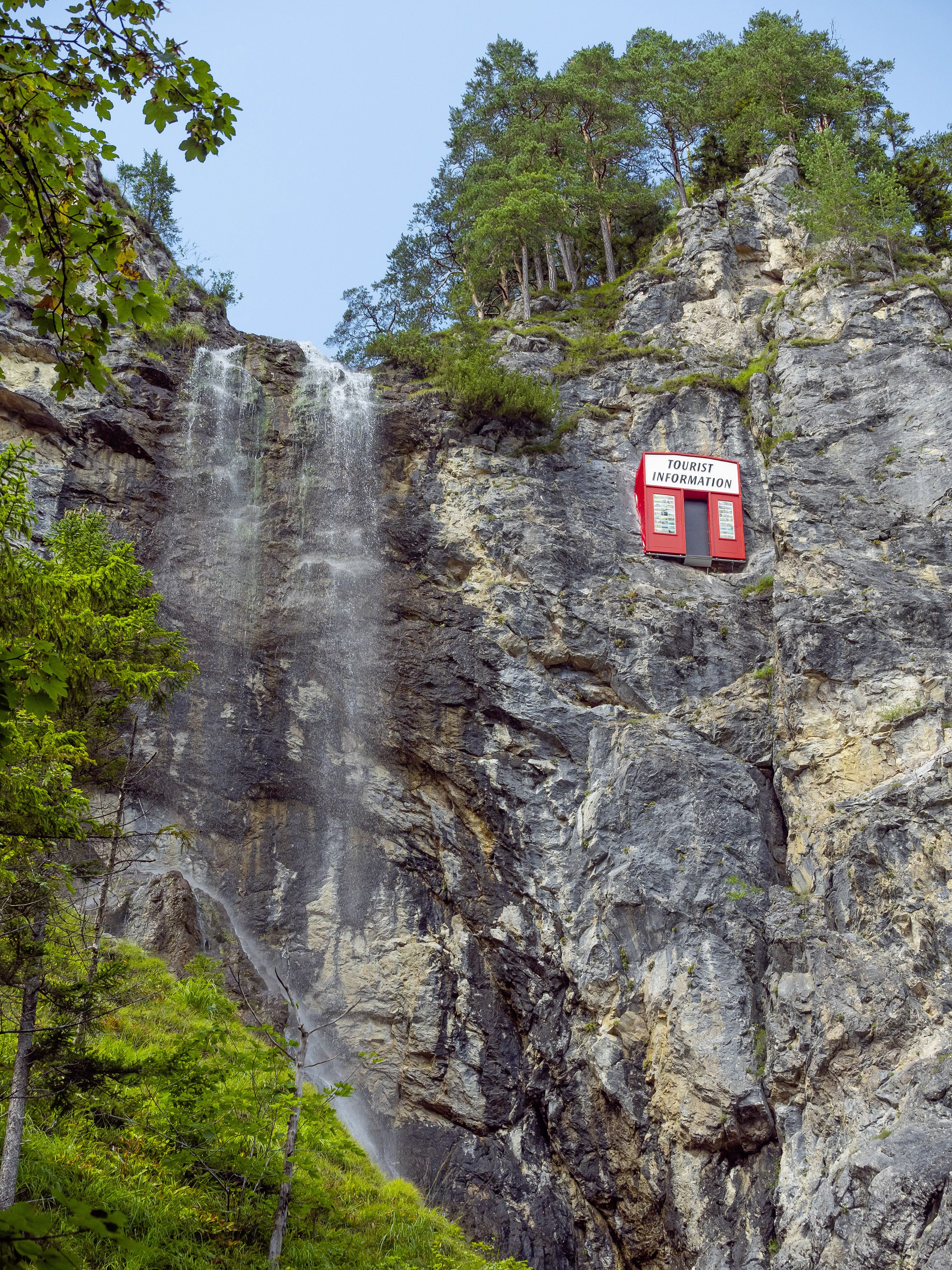Steinbrener/Dempf & Huber
:
Cliffhanger
Back
Information
The installation Cliffhanger, located in the center of the Ötscher-Tormäuer nature park, is the first project the artists’ collective Steinbrener, Dempf & Huber have realized in a remote, uninhabited landscape, far away from city life. For Cliffhanger, they mounted a bright red, 19th-century shop front with the sign “Tourist Information” onto the rock face to the right of the Mirafall waterfall. There it hangs at a staggering height that could only be reached by professional mountain climbers. As with many works by the collective, this project plays with our perspective. To people hiking on narrow and twisting trails along the steep mountain walls, this installation appears out of nowhere, almost like a hallucination. In this way, it ironically and humorously counteracts our otherwise romantic perception of nature, while exposing the seemingly untouched wild as a cultivated landscape marketed as a touristic attraction.
For more than a decade, the three artists Christoph Steinbrener, Rainer Dempf, and Martin Huber have been working with this idea, which began with a close exploration of the visual overload of urban landscapes through advertising. The work Cliffhanger transports questions regarding privatization and commercialization to the rural realm. The work’s focus on tourism was also inspired by the outbreak of the Covid-19 pandemic at the beginning of 2020. Tourism was one of the economic sectors that was the hardest hit by measures to contain the pandemic due to the almost complete standstill of global travel. Just as it became clear how many livelihoods depend on this sector, the ecological consequences of traveling also became more apparent when looking at the drop in CO2 emissions as a result of less travel. Mass tourism, which is usually associated with long-distance travel, thus particularly became a focus of much criticism.
The installation Cliffhanger is located on a popular hiking route in the recreational area and natural preserve around Mount Ötscher, which has been a tourist destination for centuries. The choice of the location encourages us to critically reflect on our own role as tourists. By being able to see the work only when we are tourists and hikers, it gives us the feeling of being “caught in the act.” Also, the area where the nature park is located—the Mostviertel region—is not yet one of the mass tourist hotspots in Austria, meaning Cliffhanger can also be understood as a kind of symbol of sustainable tourism. Historically speaking, the development of mass tourism is closely connected to the emergence of alpinism as well as the establishment of hiking as a recreational activity in the late 18th century. During this time, an image of nature and landscape developed that continues to persist in the Western hemisphere to this day: Nature is regarded as a place of longing, a place to escape from daily life, removed from civilization. That this apparent escape from the everyday economy is the root of yet another feature of civilization—namely, the development of holiday destinations that adhere to certain economic restraints and require their own infrastructures—reveals the absurdity of this phenomenon. The author Hans Magnus Enzensberger once summed this up in his article “Vergebliche Brandung der Ferne. Eine Theorie des Tourismus” (A Theory of Tourism) from 1958 as follows: “An industry has been established to manufacture deliverance from the industrial world; travel beyond the world of commodities has itself become a commodity.”[1]
Areas like the Mostviertel region and the Ötscher-Tormäuer nature park are testimony to this dialectic development. A railroad track was built to better develop this area and make the Mariazell pilgrimage site more accessible. This track was then electrified shortly after it opened and is fueled by the Wiederbruck hydroelectric power station, which was constructed for this purpose. Today, the train is used by both pilgrims and hikers. Experiencing faith and nature outside of one’s own home is thus directly connected to the changes made in the landscape and the local infrastructure. The ambivalence of the relationship between humans and water, which is explored in the video sequences created by Sylvia Eckermann and Gerald Nestler as filmic interventions accompanying Cliffhanger, can be viewed on a smartphone while hiking along the path.
Steinbrener, Dempf & Huber’s work Cliffhanger is thus an ironic and critical commentary of current events that encourages all of us (the artists included) to reflect on how we act and how we travel. Without pointing any fingers, especially as they have created another reason to hike this path to view their artwork, they transform Cliffhanger into another tourist site that will live on in numerous panoramic photographs of Mirafall.
Marijke Lukowicz
[1] Hans Magnus Enzensberger, “A Theory of Tourism,” New German Critique No. 68: 117–135 (here 139).




